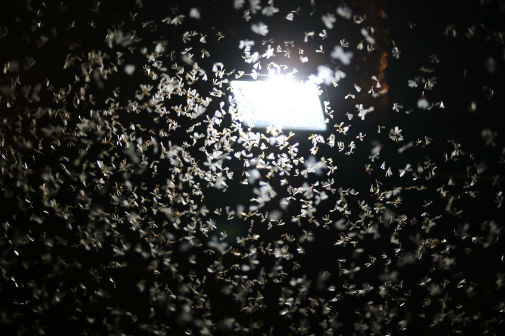Street light switch-off benefits night-time pollinators
Posted on 21 January 2019

Light pollution significantly alters moth activity and this in turn is disrupting their role as pollinators
The study, led by experts from the universities of York and Newcastle, has shown that turning off street lights even for just part of the night is effective at restoring the natural behaviour of moths.
The important role moths play in the pollination of plants – potentially even including key food crops such as peas, soybean and oilseed rape - is often overlooked. But recent studies show that moths supplement the day-time work of bees and other pollinating insects.
Nocturnal wildlife
Night-lighting disrupts nocturnal pollination by attracting moths upwards, away from the fields and hedgerows so they spend less time feeding and therefore pollinating.
However, the research team behind the study found there was no difference in pollination success between part-night lighting and full darkness.
Lead author of the study, Dr Callum Macgregor, from the Department of Biology at the University of York, said: “Often, as conservationists, we have to make difficult trade-offs between development and environmental protection.
“However, our study suggests that turning off street lights in the middle of the night is a win-win scenario, saving energy and money for local authorities whilst simultaneously helping our nocturnal wildlife.”
Ecological light pollution is increasingly linked to adverse effects on human health and wildlife. Research suggests that in disrupting the natural patterns of light and dark, artificial light has the potential to affect every level of biological organisation, from cells to whole communities.
Minimising disruption
In the last decade, many local authorities have changed their street lighting regime in a bid to cut costs and save energy. This includes switching off or dimming the lights at certain times of the night as well as replacing the traditional high-pressure sodium (HPS) bulbs with energy-efficient light-emitting diodes (LEDs).
In the study, the team analysed the impact of a range of scenarios on the pollination of moth-pollinated flowers placed underneath street lights. These included both types of lighting (HPS and LED), run either all night or switched off at midnight. Results were compared to pollination under natural darkness.
They found that regardless of the type of light, full-night light caused the greatest ecological disruption. There was no difference between LED and HPS bulbs in the part-night scenarios and in both cases, the disruption to the plants’ pollination was minimal compared to full darkness.
Environmental change
Supervisor of the study, Dr Darren Evans from Newcastle University, said: “Artificial light at night is an increasingly important driver of global environmental change and sky brightness is increasing by about 6% a year.
“Understanding the ecological impact of this artificial light on the ecosystem is vital.
“We know that light pollution significantly alters moth activity and this in turn is disrupting their role as pollinators. But what our study showed was that while full-night lighting caused significant ecological disruption, part-night lighting did not appear to have any strong effect on pollination success or quality.”
Explore more news

Children in the North at greater risk of entering care
Wednesday 17 April 2024

Boreal forest and tundra regions worst hit over next 500 years of climate change, study shows
Monday 8 April 2024

Researchers developing ultra-sensitive blood test with potential to revolutionise diagnosis of Alzheimer’s
Thursday 4 April 2024

Attitudes to being an adult are shifting as traditional milestones become out of reach, new study finds
Wednesday 27 March 2024

Scientists uncover evidence that microplastics are contaminating archaeological remains
Thursday 21 March 2024
Media enquiries
About this research
Effects of street lighting technologies on the success and quality of pollination in a nocturnally-pollinated plant is published in the journal Ecosphere.
Explore more of our research here.
